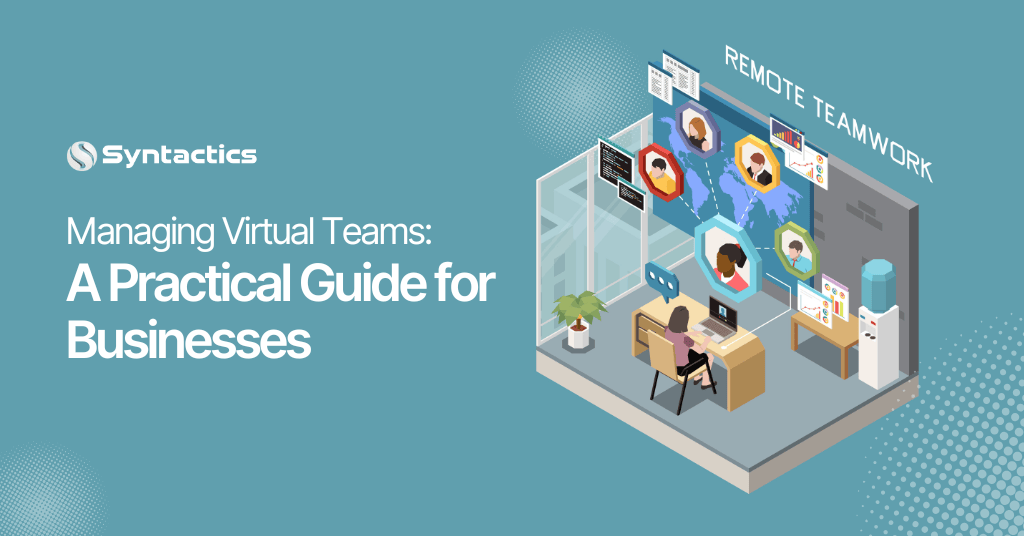
Managing Virtual Teams: A Practical Guide for Businesses
Today, you can easily hire skilled professionals online to form a virtual team. But managing them effectively is a different challenge. In fact, global conferences like Running Remote are dedicated to helping leaders succeed in managing distributed teams.
According to the recent virtual assistant industry data, many companies tap outsourcing agencies due to increased usage of AI (Artificial Intelligence) and automation. In addition, other businesses outsource to cut operational costs.
Source: Exploding Topics
Working with Remote Teams: The Challenges
Remote teams consist of digital professionals from different countries, cultures, and time zones, working together without sharing a physical workspace. This setup, enabled by digital tools and connectivity, offers flexibility but also introduces unique challenges.
However, effective collaboration requires more than just internet access. Businesses should also navigate communication gaps, time zone differences, and cultural nuances to keep everyone aligned.
Key challenges include:
- General understanding, given language and cultural differences, without physical interaction and cues.
- Coordination so that everybody is where and when they need to be with the right information, tools, materials, and skills.
- Acknowledging diversity while creating a common and acceptable team culture when working across company boundaries.
How to Manage Virtual Teams Effectively
Your team may not be in the same room, but it’s your responsibility to make sure they’re still on the same page.
Here are the best practices that you can refer to and see which ones you can implement with your existing virtual teams.
Transparency and Culture
Trust your team. One reason some companies hesitate to go virtual is the fear of lower accountability. This concern is logical and realistic. What you can do is set up clear virtual work guidelines and consequences. For example, establish a 24-hour email response rule to maintain responsiveness.
Create a strong team culture. Although your team hails from different cultures, it’s best to establish a new culture to embrace all of them. With this, build a virtual workforce atmosphere of genuine connection and intention. After all, your virtual team members are people first, not just task owners.
Allow flexible work hours — within reason. Flexibility boosts productivity, but set boundaries that keep team operations smooth and collaborative.
Meet your team when possible. If possible, meet up with your team to inspire occasionally and let your team know they are working with real people. Do team bonding, or go off on outdoor activities with them to get to know who they are in real life.
Share an inspiring video for your team. Remind the group why they are working for you and where you are leading them. Inspiration fuels engagement.
Establish and nurture your virtual friendships. Use technology to establish a dedicated workspace for celebrating special days like birthdays, milestones, as well as organization recognition for your team. Celebration builds morale and a sense of belonging.
Productivity
Organize your remote workforce. If you’re managing at scale, assign team leads to look into your remote teams. Moreover, oversee their periodic performance with reliable monitoring tools to ensure consistent output and accountability.
Set expectations and deliverables. Show examples of what and how you expect the tasks to be done. Ensure that you have clear expectations for your remote team. Besides, they can serve better when prepared and equipped.
Adopt productivity tools to track time, attendance, and output without micromanaging. Invest in online tools that work well to make collaboration possible. Consider using a virtualized desktop infrastructure to ensure remote teams can access files, attend meetings, and complete tasks without disruption.
Conduct video-based coaching. Help your team achieve the goals that they’re targeting. Identify areas for improvement and provide actionable guidance to help your team grow. If you don’t, your virtual people will end up wondering how they are doing so far.
Stay focused on goals. Focus on what needs to be accomplished. If goals aren’t being met, evaluate the root causes and address them quickly. Regular performance tracking is key to maintaining productivity across remote setups.
Communications
Engage regularly and consistently. Talk to your remote workers regularly using multiple channels of communication. As a result, this constant interaction and engagement will help the remote team feel part of the critical aspect of the company.
Consider communicating with a time zone difference. Set up a strategy to effectively talk to your team that works way beyond your traditional working hours.
Schedule a periodic performance review. Regular assessments are healthy for keeping everyone on pace with the targets.
Keep a team chat group open. Always be open to quick reminders and concerns, especially when it comes to emergencies and urgent matters. Pick the appropriate communication media (email, chat, video chat, VoIP, screen sharing, or project management tools).
Provide a two-way feedback system. Allow your virtual teams to share their experience working with your managers and what they think should also be done to improve the remote structure.
Recruitment
- Test skills and competency first before hiring. Do not just trust the résumé.
- Pay virtual teams well and on time. Beyond work, these people also have life goals and bills to settle.
- Choose new people who are fit to work with your existing team.
- Provide a long-term career path for your remote team.
- Build a standard and educational onboarding process for new hires.
Final Thoughts
Managing virtual teams, especially those from outsourcing companies in the Philippines, comes with unique challenges, but also immense potential. These professionals collaborate across time zones and cultures, powered by digital technology.
Virtual teams succeed when leaders treat them as partners, not just resources. As cultures and time zones blend, so should trust, communication, and shared goals.
Build connections that drive results, hire dedicated team of experts who understand how to make it work.
This article was updated on July 25, 2025.
FAQs About Virtual Team Management
What is a virtual team?
A virtual team consists of professionals working remotely from different locations, often across time zones and cultures, using digital tools to collaborate and deliver results.
Why do businesses hire virtual teams?
Companies often build virtual teams to cut costs, access global talent, scale operations faster, and maintain flexibility, especially in industries impacted by automation and AI.
Should I hire from an outsourcing agency or freelancers?
Outsourcing agencies offer reliability, structured processes, and scalability. Freelancers may provide flexibility and lower costs, but may lack consistent oversight and support.



















Comment 0